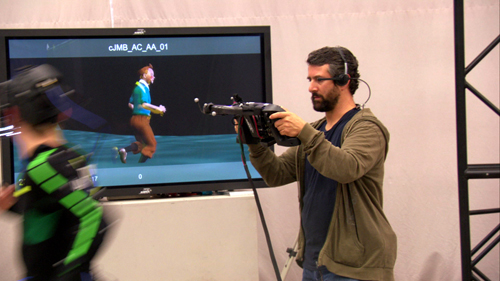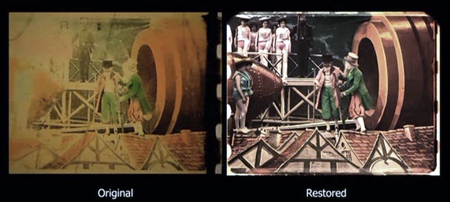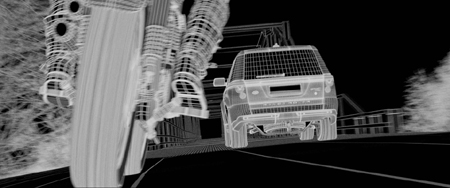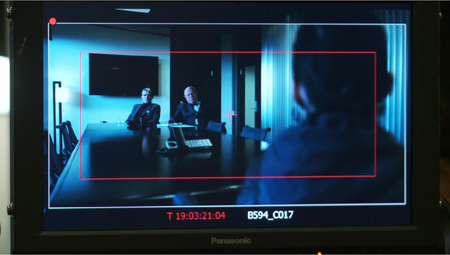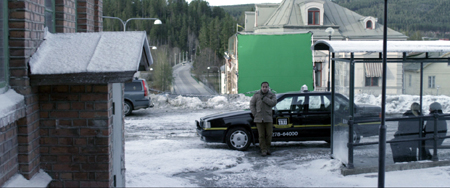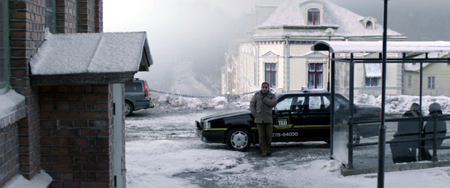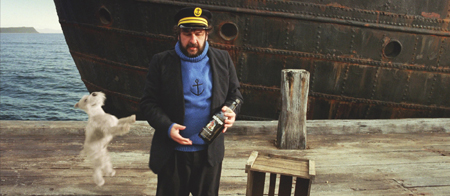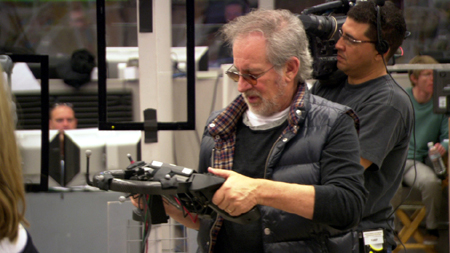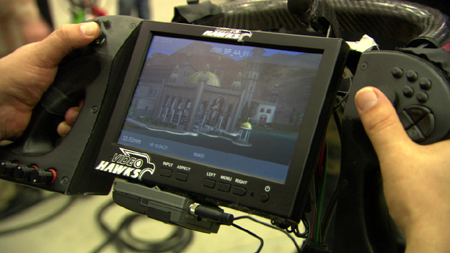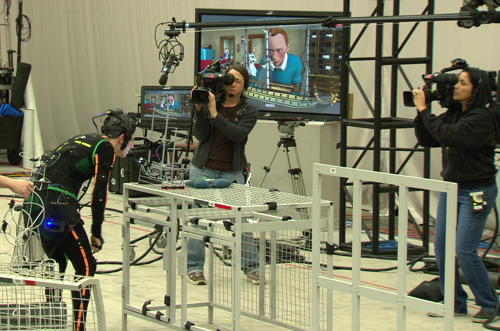Beyond praise 5: Still more supplements that really tell you something
Tuesday | July 31, 2012 open printable version
open printable version
Real-time performance-capture images for The Adventures of Tintin.
Kristin here:
The Extraordinary Voyage (2011, Serge Bromberg and Eric Lange)
I had expected to follow up my entry on Hugo when the DVD was released. I anticipated that its supplements would explore the flashy technical and artistic aspects in detail. But the lengthy first chapter proved to be largely the cast and crew presenting variations on how lucky they were to have worked with Martin Scorsese (and each other) and how much they learned from him.
That wasn’t promising, and I turned instead to Georges Méliès himself. Flicker Alley, which has served the filmmaker so well in the past (see here), has recently released the restored color version of A Trip to the Moon in a Blu-ray/DVD combination set. It is accompanied by a 65-minute documentary on the Méliès, the film, and the restoration. It’s odd to call a 65-minute film that accompanies a fifteen-minute “feature” a supplement, but I recommend it anyway.
I suspect that The Extraordinary Voyage would be quite effective in easing students into very early silent cinema and intriguing them about an era that must seem hopelessly remote to them. It begins with a charming introduction to the context of the turn of the previous century and then moves quickly into the director’s young-adult life. When it comes to the famous incident in which Méliès’ camera jammed while he was filming, creating an inadvertent magical transformation, the filmmakers have an actual 1937 recording of Méliès himself describing the event. Presumably this was the original source of this oft-repeated anecdote. He specifies that it happened on the Place de l’Opéra and involved a bus turning into a hearse. I still wonder if it all happened so neatly, but hearing it directly from Méliès makes it a little more plausible. If it wasn’t true, it should have been.
The film includes as talking heads several filmmakers who admire Méliès’ work: Costa-Gavras, Jean-Pierre Jeunet, Michael Gondry, Tom Hanks, and Michel Hazanavicius. There is a good summary of the fascination with the moon in popular culture of the day, 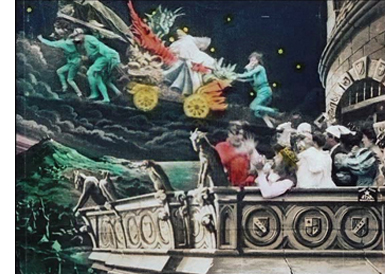 including works by Jules Verne, Jacques Offenbach, and H. G. Wells.
including works by Jules Verne, Jacques Offenbach, and H. G. Wells.
The documentary touches on issues relevant to early silent cinema in general. One of these is the frequent pirating of films, with Méliès starting an American branch of his Star Films in New York, under the direction of his brother Gaston, to help protect his intellectual property. A clip from the Segundo de Chomon version of the film, An Excursion to the Moon, is included.
At about 23 minutes in, a short overview of early movie music is given, followed by a helpful explanation of how the hand-coloring of Méliès’ films was handled by a local workshop run by women. At 30 minutes in there are several dazzling examples of hand-colored scenes (right).
After a quick summary of Méliès’ decline and death, the film moves to the restoration of the only known hand-colored copy of A Trip to the Moon, found in the film archive in Barcelona. Here the hero is Tom Burton, the Director of Technicolor Creative Services, who gives a brief indication of how computers have transformed restoration:
We have a palette of digital tools to work from that are a collection of maybe five or six of the main commercially available restoration platforms, but then we also bring into the mix all of the approaches that you would use if you were doing visual effects for a modern movie.
The comparison of visual effects with restoration is in some ways an apt one and might lead students to look upon early films in a new light.
The Girl with the Dragon Tattoo (Blu-ray/DVD/Ultraviolet set, Sony Pictures Home Entertainment)
It’s probably a good idea to supply both Blu-ray and DVD discs in one package, but including the supplements only in Blu-ray is annoying and increasingly common. That’s the way the Girl with the Dragon Tattoo discs have been handled. Teachers without access to a Blu-ray player have fewer options when trying to use supplements in teaching. It also makes it much more difficult to make frame grabs from the supplements to, say, illustrate a blog entry on useful supplements.
I decided to check out the supplements for this film because the ones for Zodiac and The Social Network were so good. I figured David Fincher was particularly concerned about his films’ bonus materials. Unfortunately this set of supplements is quite uneven. The cast and crew seem to be obsessed with the character of the heroine and with the delights of shooting in Sweden. I confess that I stopped watching some of the chapters as the talking heads went on and on about these subjects. Some of the tracks also consisted of a lot of candid behind-the-scenes footage, which is all very well, but there was little structure to this and only occasional comments to explain what was going on.
Fortunately the “Post-Production” section is very informative and interesting. “In the Cutting Room” is fairly technical but makes some fascinating points. I particularly liked the description of how Fincher eliminates reframings and unsteady shots by using the extra image space allowed by newer capture media. (Earlier digital film frames allowed no extra image area outside what would show up on the screen; as the image below indicates, the final frame can be selected from a larger picture.) This desire for a stable image in an era where the “queasi-cam” so often rules points to one distinctive trait in Fincher’s style. It indicates a willingness to actually think through the framing of each individual shot and the purpose for choosing that framing. Steven Spielberg does the same thing. Many don’t.
Editor Angus Wall talks about this advantage of the extra size of the image and how Fincher uses it to stabilize unsteady images. It’s worth quoting at length, and it demonstrates the thoughtful commentary in this particular supplement:
I’ve never seen a movie that was sort of “re-operated” to the extent that this one was. Which I think has an effect on the viewing of the movie. David is really type-A in terms of making the shots very specific. They start in a certain way, they end in a certain way. And the framing, he’s very precise in terms of his composition. He doesn’t like a lot of what you see in 99% of movies, which is very subtle moves where the operator will actually reframe according to how the actor’s moving. David doesn’t like that. Even if there were a lot of those in this film, and before, some of those takes we would have thrown out, because we just wouldn’t have been able to stabilize them to the degree that he likes it. With this, because you have this full raster, this big area around the image, you can take those images and stabilize them, really lock them down. So the movie is really locked down in terms of camera operating. More than any other movie that I can think of.
The smooth glide as the car initially approaches the country house is one example of that utter stability, used to ominous effect in that particular scene.
There’s also some interesting discussion about how the two main characters don’t meet each other until well into the film and how that affected decisions about editing. Rather than frequently intercutting between Mikael Blomkvist and Lisbeth Salander, the filmmakers decided to create longer self-contained scenes involving each, thus switching back and forth less frequently. The idea was that the exposition set forth in each scene would be too difficult to absorb if it was chopped into smaller segments. Form, style, and function, neatly explained.
Fincher also points to an interesting underlying anxiety the spectator might feel because the narrative progress gives little sense of how much action is still to come:
You don’t know where you are in the narrative. You don’t know if you’re at the beginning of the third act or … I don’t think it’s bad, because we have a five-act movie. I think that’s what’s causing everybody’s anxieties, that it doesn’t feel like, OK, here’s where we are, we’re entering the third act now. Now it feels like, fuck, this movie could go on … indefinitely. That’s the part that’s bothering me. If we told them it was going on for another forty-five minutes, they wouldn’t have a problem. It’s the indefinite part.
Since I’ve written a book claiming that classical films usually don’t have three acts, I was intrigued by this statement. (See also my earlier blog entry here and David’s essay here.) I posit instead that classical films typically create acts that run about 25 to 30 minutes, and that the film’s length determines how many acts it has. Four acts is the most common throughout Hollywood’s history, but a 158-minute film would be likely to have five acts. (Has David Fincher read my book?!) His point about the audience feeling a bit lost in an unconventional narrative structure is a rare instance of a director talking about form in such an abstract way, and it seems quite valid for The Girl with the Dragon Tattoo.
It’s also rare to get a supplement on ADR (automated [or additional] dialogue replacement), but there’s a six-minute one in the “Post-Production” section. This consists of a behind-the-scenes session with Rooney Mara supplying not just dialogue but breathing, grunts, and other noises. It’s clearly a real session, not a staged one, though the actress does seem a bit self-conscious with the documentarian’s camera turned on her. Fincher’s and Mara’s banter between takes gives a sense of what I suspect really goes on during this phase of production.
There’s a brief supplement called “Main Titles,” which deals with the form and inspiration for the CGI under the titles. Fincher wanted to tell the story of the whole trilogy in two and a half minutes, “and it has to be spectacular.” Apart from the discussion of form, there’s a good look at unrendered CGI footage compared to the finished images.
Finally, an eight-minute “Visual Effects Montage” displays a variety of special effects in a clever way. There is a section at the beginning where we are shown the image without added effects, then the same image with the areas to be altered highlighted in various superimposed colors, and finally the finished images with the effects added. This is particularly good for showing the sorts of mundane effects that are used to enhance shots unnoticeably, adding cars’ headlight beams, reflections in glass, falling snow, and the like. There is a shot with a section of a building on location blotted out with a greenscreen and the final shot showing the use of alterations in the building:
Obviously here the fog was also added with CGI.
This montage goes very quickly. If you’re using it in a class, best to prepare ahead and be ready to pause and point out what’s going on in the many short shots used in the demonstrations.
The second half of the effects montage moves to splashier scenes of the type the public associates with “special effects”: wire-frame vehicles for a chase (see image at the top of this section), head-replacement to add Mara’s head to her stunt-double’s body, and explosions.
Don’t bother with the “Stockholm Syndrome” section. Basically all we learn is that when a scene is shot on location, sheep can unexpectedly wander in and interfere.
The Adventures of Tintin (Blu-ray/DVD/Digital Copy combo, Paramount Pictures)
Again, the supplements for this release are available only in Blu-ray.
Steven Spielberg and Peter Jackson decided some years ago to collaborate on what was announced to be a three-film series adapted from Hergé’s Tintin comic books. The notion was that each of them would direct one film, with an as-yet-unspecified director doing the third. Spielberg’s initiatory film did not do as well at the domestic box-office as had been hoped, though it fared better in Europe and other non-North American markets, where the comics are highly popular. Jackson has announced that after he finishes both parts of The Hobbit, he will launch into the next Tintin film. (At least, that’s what he said originally. After yesterday’s announcement that there will be three Hobbit films, his start on the Tintin film will presumably be delayed.)
The supplements form a narrative of the film’s making, bookended by “Toasting Tintin” and “Toasting Tintin Part 2,” brief episodes set at the launch and wrap parties. The tale is pleasant and generally worth watching, though they are far from as entertaining and informative as the supplements that Michael Pellerin produced and directed for Jackson’s The Lord of the Rings and King Kong DVD sets. But this is Spielberg’s show, since he did the first film and indeed originated the project. At first he envisioned the film as live-action, with the dog Snowy the only major CGI character. Spielberg asked Jackson’s effects house Weta Digital to do some tests animating Snowy. To his (apparent) surprise, Jackson himself, as a fan of the comics since childhood, played Captain Haddock in the test. That fact was well known to fans, and the inclusion of the test footage (above) is no doubt a crowd-pleaser.
The decision to use cutting-edge performance-capture techniques led to the film being entirely animated.
“The World of Tintin” gives background on Hergé and deals briefly with the screenwriting process. This leads into “The Who’s Who of Tintin,” dealing with characters and acting, with some good material on performance capture near the end. The next section, “Tintin: Conceptual Design” has good material on the visual style of the characters and near the end includes some pre-viz material.
The outstanding supplement, however, is “Tintin: In the Volume,” nearly 18 minutes of footage concerning performance capture. Spielberg’s role as director was primarily concentrated into a remarkably short 31-day shoot with the actors. This was done in a state-of-the-art performance-capture facility called “The Volume” and located at Giant Studios. The Volume is a large space with about 160 cameras built into the ceiling and pointing down into the performance space. These capture the space from multiple angles. Additional cameras on the stage level follow the actors’ movements, which are inserted into the space. Moreover, hand-held monitors similar to portable gaming devices allow the filmmakers to see simple versions of the settings and the partially rendered characters while pointing the device at the actors in their performance-capture rigs.
There are also larger monitors that show the actors their own performances translated into the characters (top of entry). Whatever one thinks of the look of contemporary animation of this type, the technology has evolved to a remarkable level, and this supplement provides an excellent explanation of the practicalities of performance capture. We see the motion-capture suits being put on and the dots painted onto the actors’ skin. There is also information on how the set elements and props need to be transparent so that the cameras can capture the dots on the actors’ faces and costumes through them. The image at the bottom shows Jamie Bell as Tintin looking at a mock-up of the model ship. It’s made of little metal rods and rendered into a ship on the monitors.
“Snowy: From Beginning to End” is less cutesy than it sounds. It discussed the digital tool developed for modeling the dog’s fur. There’s also good stuff on how several dogs were recorded to provide different-sounding barks depending on the type of action in a scene.
The biggest tasks on the film came after the performance capture and editing. Weta Digital spent two years creating the final images. “Animating Tintin” is an excellent eleven-minute account of that process.
The sections “Tintin: The Score” and “Collecting Tintin” (on Weta Workshop’s designs for the collectible figures) are rather thin and could be skipped unless a teacher wants to show the whole set of supplements as a single “making-of” documentary.
It’s become apparent that many of the best supplements on Blu-ray and/or DVD releases are devoted to special effects, especially performance capture. The Adventures of Tintin does genuinely involve innovations in this technology, and the “In the Volume” chapter is very informative. Supplements are getting repetitive, though, and I would like to see the producers of such documentaries pay more attention to techniques and choices in other areas. Comparing final cuts of scenes with earlier cuts, or showing story conferences where real debates about scripts occur (as was done in the first Pirates of the Caribbean film’s supplements), or displaying how decisions about digital-intermediate grading are made–a bit of imagination could spice up the offerings. That and a realization that film fans are interested in just about any aspect of production (or distribution, for that matter). Supplements risk falling into conventional patterns, and that won’t make them the appealing bonus material that they used to be.
While I was gearing up to write this entry, we received Mark Parker and Deborah Parker’s book, The DVD and the Study of Film: The Attainable Text (Palgrave, 2011). Based on a great deal of research, including many interviews, the authors include a summary history of DVDs and supplements; there is a detailed chapter on The Criterion Collection, interviews with directors and scholars who have recorded commentary tracks, and a case study of Atom Egoyan.












